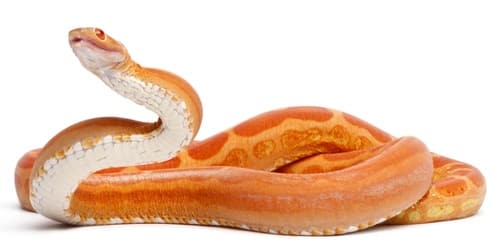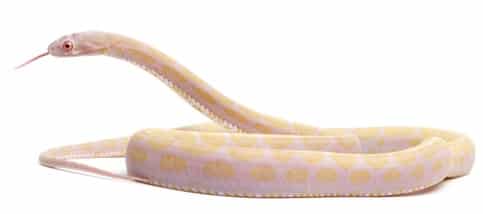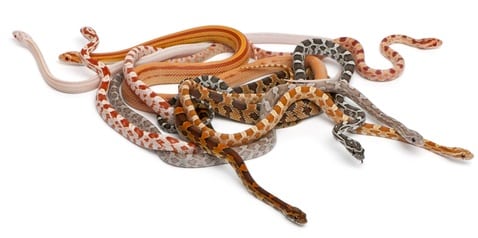Scaleless corn snakes don’t have as many scales as regular corns. This mutation is a recessive gene. Some have a few, and others have almost no scales along their backs and sides. If they have some scales, they may run in a line along their back. Despite not having scales, their skin retains its color. You can still see their pattern, which is on their skin, not their scales.
All scaleless corn snakes still have belly scales (ventral scales). This is crucial as these scales protect the snake as it slithers on the ground. A scaleless corn snake’s skin is smooth, just as its scales would be but, in sections where it coils, its skin wrinkles up. It can be bred to create designer morphs like scaleless albinos and scaleless palmettoes.
Their lack of scales also means that they are softer to hold than regular corns. According to the European Journal of Histochemistry, this is because they lack beta-keratin, which is what toughens their scales.
What Is a Scaleless Corn Snake?
Novices could be forgiven for thinking that scaleless corn snakes are a man-made morph, but they aren’t. Scaleless snakes have been found in the wild for decades. From the evidence, they are able to survive in the wild.
Scaleless snakes of other species were discovered before the first scaleless corn snake. A scaleless western garter snake was found in 1942. It was only in 1971 that a scaleless gopher snake was found.

It’s believed that the first-ever scaleless corn snake is the result of a cross with a Texan rat snake, which would explain where the mutation came from, as wild scaleless rat snakes have been discovered.
It’s likely that Brian Barczyk first bred them at B.H.B. Enterprises. Brian has been breeding scaleless snakes for years, of several species.
Scaleless Corn Snake Morphs
Scaleless corns are a morph in themselves. When bred with other morphs, you can create ‘designer morphs’. The gene that causes these snakes to not have scales doesn’t affect their color or pattern. So, despite having recessive genes, they can still be made into designer morphs.
| Scaleless Albino: | Bright orange-red with cream pattern. |
| Scaleless Tessera: | The same color as normals, but with a unique pattern. |
| Scaleless Anery: | Lacking red and yellow pigments, they look a grey, brown and black instead. |
| Scaleless Blizzard: | Usually light pink with red eyes. |
| Scaleless Lavender: | Light pink background with purple-gray markings. |
| Scaleless Palmetto: | Almost pure white, but with red, black. and brown spotted markings. |
Scaleless Albino
Albinism is the result of another recessive gene, like the scaleless snake. Albinism is also referred to as amelanism. That’s because albinos lack melanin, i.e. the pigment that causes dark patterns and colors.
Because albinism is recessive, breeding the first scaleless albino corn snake would have taken at least two generations. The first generation would be heterozygous, and the second generation would be homozygous. The albino gene would finally show.
Albinos aren’t pure white. Instead, they’re a bright red-orange color with a yellow, white, or cream pattern. They also have red eyes. The scaleless albino has these colors, and the red eyes, but not scales.
Scaleless Tessera
Tessera corns have a unique pattern that appears more broken, almost pixelated, compared to a regular corn snake. They also have a distinctive line along their back. This line is lighter, and the pattern around it is darker.
The tessera gene is a dominant one. Creating a scaleless tessera corn snake is easy. If the tessera is homozygous for its gene, all offspring from that snake and a scaleless snake will be scaleless tesseras.
Scaleless Anery
Anerythristic (or ‘anery’) corns are also known as black albinos. They’re a complement to albinos in that they too lack pigment in their skin. But, instead of lacking melanin, they don’t have any erythrin.
Erythrin is a pigment that causes warm reds, oranges, and yellows. When a snake lacks these pigments, they look mostly black, gray, and brown.
There are two types of anery corns. The first is anery Type A, which looks as described above. Anery Type B snakes are also known as charcoals. They have a more muted contrast compared to Type A. When bred with a scaleless snake, they keep their pattern and color, and lose their scales.
Scaleless Blizzard
Blizzard corns are a designer morph bred from charcoal (anery type B) and albino parents.
Their combination of genes was deliberately planned. Charcoals lack erythrin, and albinos lack melanin. When these genes both act, the snake is left with almost no pigment in their skin. This means that they’re pure white. They may develop some yellowing as they age.
Also, because they’re bred from albinos, they have pink or red eyes. When combined with their white appearance, their eyes are striking.
Without scales, the effect is even more impressive. Their skin is almost translucent. That means that the red of their blood shows through. They are a light to medium pink color.
Scaleless Lavender
Lavender corns have a light pink background. Their dark markings range from purple to gray. A lavender’s eyes might also be a different color. They may be ruby red, or a deeper burgundy. Scaleless lavenders keep this pattern and color combination, but have no scales.
Scaleless Palmetto
Palmettoes are beautiful to look at, and they are rare. When they hatch, they’re candy pink. As they age their pink fades and turns into a pure white. But throughout their whole body, individual scales stand out. These scales may be red, black or brown.
These scales are mostly unconnected, and are spread out across their whole body. They appear mostly along their back. From a distance, they look like small flecks in ice cream. The flecks fit into the borders of each scale. A scaleless palmetto retains this color and pattern, despite not having scales.
There are many more scaleless corn snake morphs. Scaleless snakes can be bred to any other morph, and result in a designer morph. That’s because of how corn snake genetics work.

Scaleless Corn Snake Genetics
An animal inherits two sets of genes: one from its mother and one from its father. These genes combine to create something new.
The animal will maintain two genes for each of its qualities. Take eye color, for example. It inherits an eye color gene from its mother, and an eye color gene from its father. These genes can interact in 3 different ways:
| Dominant genes: | These genes will always be shown. |
| Recessive genes: | These genes that won’t be shown if the other gene from the other parent is dominant. |
| Co-dominant genes: | These genes that will appear alongside both dominant and recessive genes. This results in a mixed appearance. |
The scaleless corn snake gene is recessive. That means if a snake has the recessive scaleless gene, but also has a dominant ‘normal scales’ gene, the snake will have normal scales. The only way to breed a scaleless snake is for them to get the scaleless gene from both parents.
Genetic Problems
One issue with scaleless corn snakes is their eyes. A snake’s eyes are each covered by a scale (the brille). This acts as an immovable eyelid, and protects the eye from dust and scratches.
In scaleless corns, they do still have a thin layer over their eyes. But this thin layer isn’t a hardened scale like in other snakes. You have to be careful with them and avoid damaging their eyes.
Aside from that, scaleless snakes don’t have a problem eating, breeding, going to the toilet, or anything else. They don’t seem to have shorter lifespans than regular corn snakes. As such, you may think that breeders should start breeding more of them!
Should You Breed Scaleless Corn Snakes?
Many owners and breeders believe that you shouldn’t breed scaleless snakes. There are several reasons why:
- They would be easier for a predator to attack and eat in the wild
- Their lack of scales means they would be scratched more easily, and damage would be more serious
- Their lack of scales makes their eyes vulnerable
- They often have bug-eyes, which may be painful. They may also make it difficult for them to survive in the wild
However, many scaleless snakes have been caught in the wild of all ages. This indicates that they survive into adulthood, although it’s not clear whether they survive to adulthood less often.
Breeding Scaleless Corn Snakes
The first method is to have two scaleless corn snakes breed. A scaleless snake must have a pair of scaleless genes to appear scaleless. In other words, it doesn’t inherit the normal-scales gene from either parent.
This is referred to as ‘homozygous.’ This means that both of the animal’s genes for a particular thing are the same. All snakes with recessive genes, like albinos, have to be homozygous in order to appear different to normal. Therefore, if you breed two scaleless corn snakes together, 100% of the offspring will be scaleless too.
The other way of breeding scaleless corn snakes is with ‘heterozygous’ snakes. The parents may not be scaleless, but can still pass on the scaleless gene if they carry it. In this scenario, not all the offspring will be scaleless, only some. Here’s a breakdown:
| 25% of the offspring will be scaleless: | The odds of each parent passing on their scaleless gene is ½. The odds of them both doing so at the same time is ¼, hence 25%. |
| 25% of the offspring will be normal: | They will have 2 sets of the normal scale gene. |
| 50% of the offspring will be heterozygous for the scaleless gene: | They will not appear scaleless, but will still carry the gene and can pass it on. |
A breeding program based on homozygous scaleless snakes is therefore far more efficient.
How to Breed a Scaleless Corn Snake
In all other respects, breeding scaleless corn snakes is the same as breeding regular corns. Here’s a brief step-by-step guide:
- Start with a healthy male and female. Check them for health conditions, like scale rot, before starting the breeding program.
- Temperature cycle the snakes. Lower the temperature of their enclosure in the fall and raise it again in the spring.
- Introduce the snakes after temperature cycling. Spring is the time that snakes mate. Put the male in the female’s enclosure.
- Watch the snakes. They may fight initially. If they get especially defensive, separate them and try again tomorrow.
- Check that the snakes become locked. This is where the male wraps his tail around the female’s tail. His hemipene enters her cloaca, which is how snakes mate.
- Reintroduce the snakes each day. Continue until you’re sure the female is gravid.
Once the female lays her eggs, you have to transfer them to an egg box. Inside the egg box, they then have to go into an incubator. This ensures that the maximum number of eggs hatch.
For more detailed information, see our guide on corn snake breeding. It details each stage, and describes all the equipment you might need.

